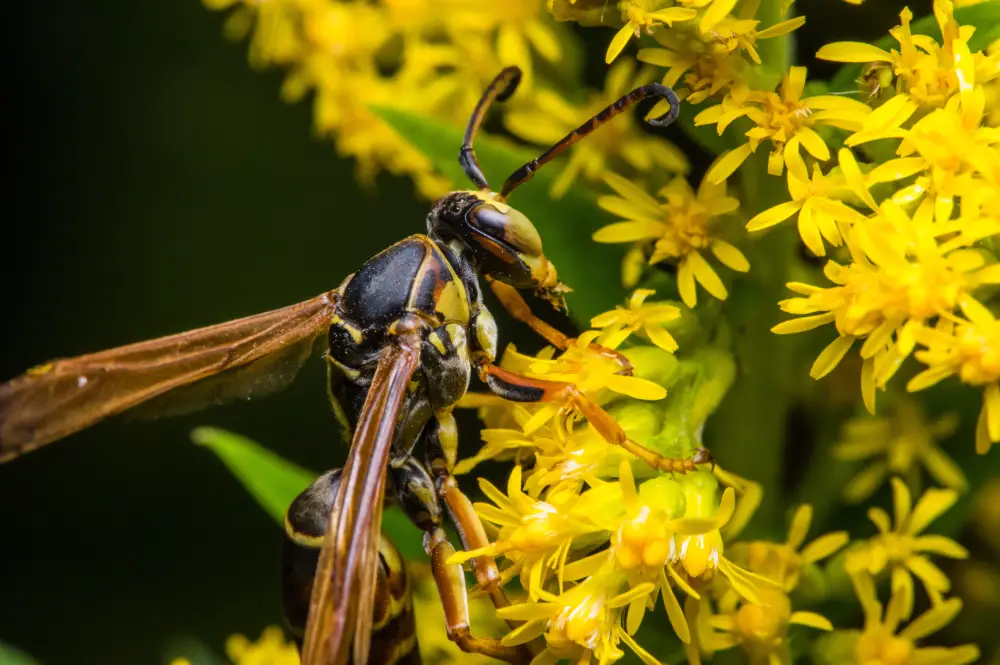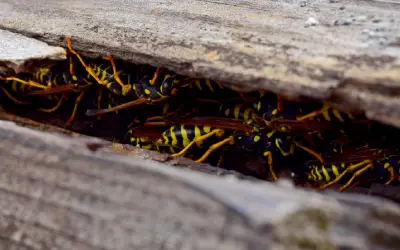
Getting stung is painful, and here in Florida, where Sorko Services is based, stinging insects are all over the place. That’s why we thought it would be helpful to go over all of them in this comprehensive guide to stinging insects in Florida. That way, the next time you get stung, you can easily determine what got you and how concerned you should be.
Let’s get started by breaking down stinging insects into a few basic categories. After that, we’ll break down each species specifically, telling you what you need to know about risk factors.
Types of insects that sting you (or, in some cases, bite) in Florida:
- Bees: Most bees aren’t aggressive, but they can become aggressive if they believe their colony is under threat. Species include honey bees, bumblebees, carpenter bees, Africanized bees, sweat bees, and mining bees.
- Wasps: Many types of wasps are much more aggressive than bees, and it’s always a good idea to keep your distance. Examples include paper wasps, bald-faced hornets, yellowjackets, and less harmful types like cicada killer wasps and mud daubers.
- Stinging Ants: Most ant stings happen when you’ve unwittingly trampled over their colony. Common stinging ants in Florida include fire ants, harvester ants, and velvet ants.
- Biting Flies: Technically, biting flies don’t sting – they bite. But it feels similar, so we’re listing them here. Common species include horse flies, deer flies, black flies, sand flies (“no see ums”), and yellow flies.
Ready for pest, lawn, or sprinkler service?
Ready for qualified professionals to help keep your home, business, or lawn in pristine condition?
Get your home, lawn, and lake in pristine condition. Leave your information and we'll be in touch.
*During normal business hours. After hours calls will be returned the next business day.
Which Bees Sting in Florida?
One thing that’s important to understand about bees is that, for the most part, they’re extremely colony-minded. Drones have a job to do, and they would rather focus on their work than try to intimidate or sting you. So if you leave them alone, chances are they’ll leave you alone, too.

But it doesn’t always happen that way. Bees can misinterpret your actions as aggressive, or you can accidentally walk right into an area with a buzzing nest, and they may defend it without warning. And it’s also nearly impossible to tell your average honeybee apart from its much more aggressive cousin, the Africanized bee.
Here are the bees in Florida that are most likely to sting you:
- Honey Bees: Known for producing honey and beeswax, these social insects live in large colonies and have barbed stingers that they leave behind, resulting in their own death after stinging. Risk Factor: Low to Moderate.
- Bumblebees: Often recognized by their fuzzy, round bodies, bumblebees are generally docile and can sting multiple times as their stingers are not barbed. Risk Factor: Low.
- Carpenter Bees: These solitary bees resemble bumblebees but have a smooth, shiny black abdomen. Females can sting, but rarely do unless provoked, and their stings are not barbed. Risk Factor: Low.
- Africanized Bees: Also known as “killer bees,” these highly defensive bees are a hybrid species known for their aggressive swarming behavior and ability to sting in large numbers. Their stingers are barbed. Risk Factor: High.
- Sweat Bees: Small and metallic, these bees are attracted to human sweat. Their stings are generally mild and feel like a pinprick, and they can sting multiple times. Risk Factor: Low.
- Mining Bees: Solitary ground-nesting bees, mining bees are typically docile and only sting if handled or threatened. Their sting is usually mild and temporary. Risk Factor: Low.
Which Wasps Sting in Florida?
Similar to bees, wasps spend most of their time minding their own business, searching for food and water. However, it’s important to understand that some types of wasps are just jerks, and they can be aggressive for seemingly no reason.

Perhaps you stepped into their territory without realizing (they often claim large areas as their territory, so it’s difficult to know). Or maybe the smell of a cookout drew them over, and suddenly they decide to attack. Also, the aggressiveness of wasps can vary from nest to nest. For example, some yellowjacket nests are a lot more aggressive than others. It’s difficult to predict, and that’s why, with wasps, keeping a safe distance and calling a wasp exterminator is always the best option.
Here are the most common types of wasps in Florida:
- Yellow Jackets: Notoriously aggressive, these wasps can sting multiple times and are protective of their nests. Be sure to check out our article on how to identify yellowjackets on your property. Risk Factor: High.
- Paper Wasps: Recognizable by their long legs and distinctive nests, they are moderately aggressive and will defend their territory if threatened. Risk Factor: Moderate.
- Bald-Faced Hornets: Larger and with a striking black-and-white pattern, they are quite territorial but less likely to attack unless their nest is disturbed. Risk Factor: Moderate.
- European Hornets: Larger than other wasp species, these hornets can be aggressive if their nest is threatened. They are active at night and are attracted to lights. Risk Factor: Moderate.
- Mud Daubers: These wasps are non-aggressive and beneficial as they help moderate spider populations. You can easily identify them by their slender, thread-waisted bodies. Risk Factor: Low.
Ready for pest, lawn, or sprinkler service?
Ready for qualified professionals to help keep your home, business, or lawn in pristine condition?
Get your home, lawn, and lake in pristine condition. Leave your information and we'll be in touch.
*During normal business hours. After hours calls will be returned the next business day.
What Types of Ants Sting in Florida?
Ant stings are less common than bee or wasp stings because stinging ants tend to stay closer to their colonies. However, if you have the misfortune of walking into a stinging ant colony, you’ll find that the stings are extremely painful, and many stings can come at once. Often, they’ll climb up your legs and bite you there. They can be tough to eliminate without a professional ant exterminator.

Here are the most common stinging ants in Florida:
- Fire Ants: Small, reddish-brown ants that deliver a painful, burning sting. They often build large mounds in open areas. Risk Factor: High.
- Harvester Ants: Larger ants known for their habit of collecting seeds. Their sting is potent and can cause localized pain and swelling. Risk Factor: Medium.
- Velvet Ants: This is actually a bit of a misnomer because velvet ants are not ants. Despite their name, these are actually wingless female wasps, often brightly colored and covered in dense, velvety hair. Their sting is renowned for its intense pain. Risk Factor: Very High.
Do Flies in Florida Sting?
Technically, flies don’t sting – they bite. But if you’ve ever gotten bitten by a horsefly, you know the pain can hurt just as much as a bee sting. And flies can be even tougher to detect than bees, wasps, or ants because they’re smaller and quieter. “No see ums” especially pop up, leave several painful bites, and then disappear.
These are the most common biting flies in Florida you should watch out for:
- Horse Flies: Large, aggressive flies with painful bites, often found near livestock and water. Risk Factor: High
- Deer Flies: Similar to horse flies but smaller, known for their greenish eyes and zigzag flight patterns. Risk Factor: Medium.
- Black Flies: Tiny, humpbacked flies that bite in swarms, leaving itchy, red welts. Risk Factor: High.
- Sand Flies (“No-See-Ums”): Extremely small biting midges, their bites are disproportionately itchy and irritating. Risk Factor: High.
- Yellow Flies: Medium-sized, yellowish flies with dark wings; their bites are painful and can cause swelling. Risk Factor: Medium.
Call Us for Stinging Insect Control in Florida
Did you hear the power players in Tallahassee were thinking about changing our name from The Sunshine State to The Bug Sting State? Just kidding, but with everything from aggressive yellowjackets and killer bees to painful fire ants lurking around every corner, Florida certainly keeps us on our toes.
Whether you’re dealing with an aggressive wasp nest or a biting fly problem, Sorko Services‘s stinging insect exterminators have the local expertise to handle even the toughest challenges in Central Florida.
Contact us today and get back to enjoying your outdoor spaces without the constant threat of painful stings.
Back to Bee and Wasp Control